Olympic weightlifting
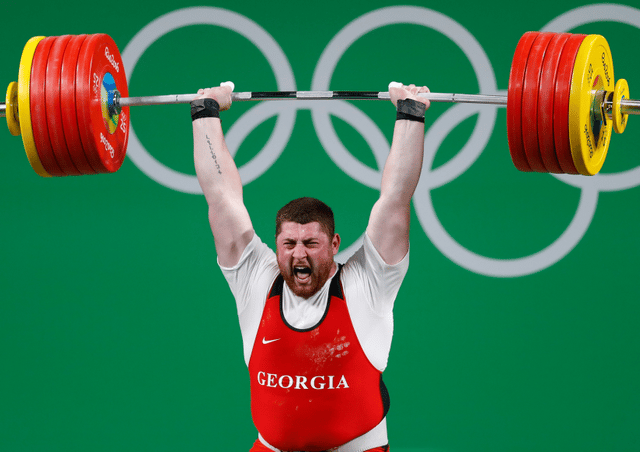
Olympic weightlifting

| Highest governing body | International Weightlifting Federation |
|---|---|
| First developed | Ancient Greece, Egypt, China |
| Characteristics | |
| Contact | No |
| Mixed gender | No |
| Type | Strength sport |
| Equipment | Barbells, weight plates, collars, chalk, tape, shoes, belt |
| Presence | |
| Country or region | Worldwide |
| Olympic | Men: 1896, 1904, 1920 – present; Women: 2000 – present |
| World Games | Women: 1997 |
Olympic-style weightlifting, or Olympic weightlifting, often simply referred to as weightlifting, is an athletic discipline in the modern Olympic program in which the athlete attempts a maximum-weight single lift of a barbell loaded with weight plates.
The two competition lifts in order are the snatch and the clean and jerk. The snatch is a wide-grip, one-move lift. The clean and jerk is a close-grip, two-move lift. Each weightlifter receives three attempts in each, and the combined total of the highest two successful lifts determines the overall result within a bodyweight category. Bodyweight categories are different for male and female competitors. A lifter who fails to complete at least one successful snatch and one successful clean and jerk also fails to total, and therefore receives an "incomplete" entry for the competition. The clean and press was once a competition lift, but was discontinued due to difficulties in judging proper form.
In comparison with other strength sports, which test limit strength (with or without lifting aids), weightlifting tests aspects of human ballistic limits (explosive strength); the lifts are therefore executed faster—and with more mobility and a greater range of motion during their execution—than other strength movements.
The lifts performed in the sport of weightlifting, and in particular their component lifts (e.g. squats, deadlifts, cleans), are commonly used by elite athletes in other sports to train for both explosive and functional strength.
| Highest governing body | International Weightlifting Federation |
|---|---|
| First developed | Ancient Greece, Egypt, China |
| Characteristics | |
| Contact | No |
| Mixed gender | No |
| Type | Strength sport |
| Equipment | Barbells, weight plates, collars, chalk, tape, shoes, belt |
| Presence | |
| Country or region | Worldwide |
| Olympic | Men: 1896, 1904, 1920 – present; Women: 2000 – present |
| World Games | Women: 1997 |
Competition
The sport is controlled by the International Weightlifting Federation (IWF). Based in Budapest, it was founded in 1905.
Weight classes
Athletes compete in a division determined by their body mass. In Summer of 2018, the IWF approved the current weight categories, specifying which 7 of the 10 total would be contested at the Olympics.[1]
Men's weight classes:
IWF Categories
55 kg (121 lb)
61 kg (134 lb)
67 kg (148 lb)
73 kg (161 lb)
81 kg (179 lb)
89 kg (196 lb)
96 kg (212 lb)
102 kg (225 lb)
109 kg (240 lb)
109 kg and over (240 lb+)
Olympic Categories
61 kg (134 lb)
67 kg (148 lb)
73 kg (161 lb)
81 kg (179 lb)
96 kg (212 lb)
109 kg (240 lb)
109 kg and over (240 lb+)
Women's weight classes:
IWF Categories
45 kg (99.2 lb)
49 kg (108 lb)
55 kg (121 lb)
59 kg (130 lb)
64 kg (141 lb)
71 kg (157 lb)
76 kg (168 lb)
81 kg (179 lb)
87 kg (192 lb)
87 kg and over (191 lb+)
Olympic Categories
49 kg (108 lb)
55 kg (121 lb)
59 kg (130 lb)
64 kg (141 lb)
76 kg (168 lb)
87 kg (192 lb)
87 kg and over (191 lb+)
Official procedure
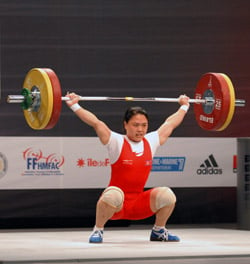
Snatch
In each weight division, lifters compete in both the snatch and clean and jerk. Prizes are usually given for the heaviest weights lifted in each and in the overall—the maximum lifts of both combined. The order of the competition is up to the lifters—the competitor who chooses to attempt the lowest weight goes first. If they are unsuccessful at that weight, they have the option of reattempting at that weight or trying a heavier weight after any other competitors have made attempts at the previous weight or any other intermediate weights. The barbell is loaded incrementally and progresses to a heavier weight throughout the course of competition. Weights are set in 1 kilogram increments. If two athletes lift the same weight, they are both credited with it but in terms of placing the one who lifted the weight first gets the highest placing.[1]
During competition, the snatch event takes place first, followed by a short intermission, and then the clean and jerk event. There are two side judges and one head referee who together provide a "successful" or "failed" result for each attempt based on their observation of the lift within the governing body's rules and regulations. Two successes are required for any attempt to pass. Usually, the judges' and referee's results are registered via a lighting system with a white light indicating a "successful" lift and a red light indicating a "failed" lift. This is done for the benefit of all in attendance be they athlete, coach, administrator or audience. In addition, one or two technical officials may be present to advise during a ruling.
Local competition rules
At local competitions, a "Best Lifter" title is commonly awarded. It is awarded to both the best men's and women's lifters. The award is based on a formula which employs the "Sinclair Coefficient", a coefficient derived and approved by the sport's world governing body and which allows for differences in both gender and bodyweight. When the formula is applied to each lifter's overall total and then grouped along with the other competitors' and evaluated, it provides a numeric result which determines the competition's best overall men's and women's lifters.[2] And while, usually, the winner of the heaviest weight class will have lifted the most overall weight during the course of a competition, a lifter in a lighter weight class may still have lifted more weight both relative to their own bodyweight, and to the Sinclair coefficient formula, thereby garnering the "Best Lifter" award.
History
Pre-Olympic
Competition to establish who can lift the heaviest weight has been recorded throughout civilization, with the earliest known recordings including those found in Egypt, China and ancient Greece. Today, the modern sport of weightlifting traces its origins to the European competitions of the 19th century.
The first male world champion was crowned in 1891; the weightlifters were not categorized by weight at this time, and a women's championship did not exist until 1987.
Early Olympic
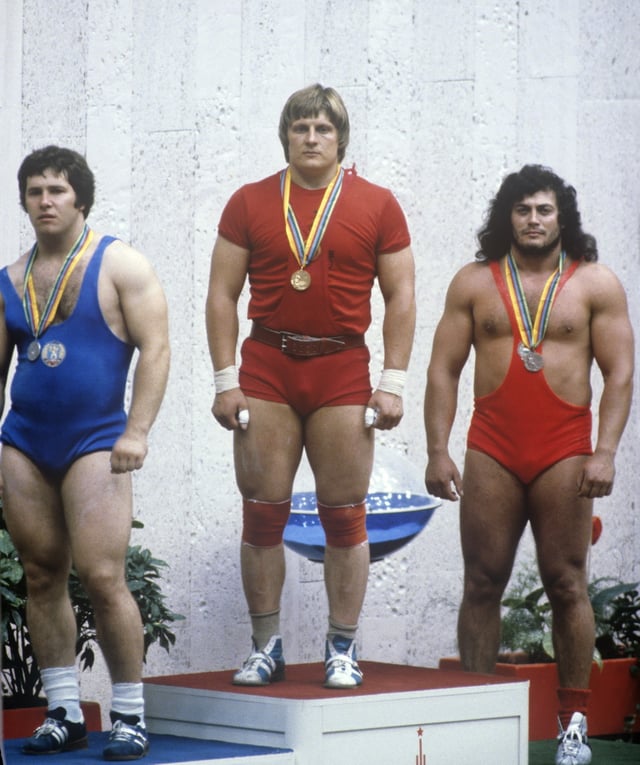
The 110 kg division weightlifting winners of the 1980 Olympic Games, held in Moscow
The first Olympic Games of 1896 included weightlifting in the Field event of the predecessor to today's track and field or athletics event. During the 1900 Olympic Games, there was no weightlifting event. Weightlifting resumed as an event, again in athletics, in 1904 but was omitted from the Games of 1908 and 1912. These were the last Games until after the First World War. In these early Games, a distinction was drawn between lifting with 'one hand' only and lifting with 'two hands'. The winner of the 'one hand' competition in 1896 was Launceston Elliot, while the winner of the 'two hands' event was Viggo Jensen of Denmark.[3]
In 1920, weightlifting returned to the Olympics and, for the first time, as an event in its own right. At these Games, which took place in Antwerp, Belgium, fourteen nations competed. The competition lifts were the 'one hand' snatch, the 'one hand' clean and jerk and the 'two hands' clean and jerk. At the next Olympic Games, in Paris, France, in 1924, the 'two hands' press and the 'two hands' snatch were added to the program, making a total of five lifts.
In the Olympic Games after 1920, instead of requiring all competitors to compete against each other regardless of size, weight classes were introduced and, by the 1932 Olympic Games, weightlifting was divided into five weight divisions.
In 1928, the sport dropped the 'one hand' exercises altogether leaving only the three remaining exercises: the clean and press, the snatch and the clean and jerk.
Modern Olympic
After the 1972 Olympics, the clean and press was discontinued due to difficulties in judging the event. Athletes had begun utilising their hips and leaning backwards substantially rather than 'strictly' pressing the weight overhead with an upright torso. The rules prohibited 'excessive layback,' but it was considered too difficult to determine what degree of layback constituted a breach of the rules and so the event was removed from the program. What remained are the two elements of the modern Olympic weightlifting program – the snatch and the clean and jerk. The snatch consists of lifting the barbell from the floor to an overhead position in one fluid motion. It is a very precise lift that can be nullified by a lack of balance of the athlete. The clean and jerk consists of moving the barbell from the floor to overhead in 2 movements: from the floor to the shoulders, and from the shoulders to overhead.
Women's Olympic
In 2011 the International Weightlifting Federation ruled that athletes could wear a full-body "unitard" under the customary weightlifting uniform.[8] Kulsoom Abdullah became the first woman to do so at the U.S. National Championships that year, and athletes are allowed to do so at the Olympics.[8] IWF rules previously stated that an athlete's knees and elbows must be visible so officials can determine if a lift is correctly executed.[8]
Equipment
Barbell
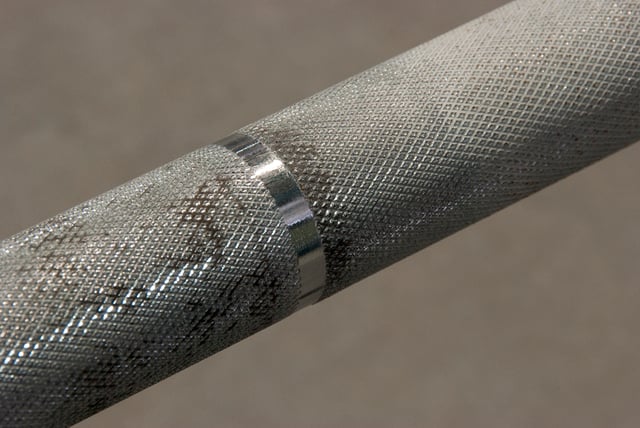
Knurling on an Olympic barbell
Olympic weightlifting uses a steel bar (also known as a barbell) with larger-diameter rotating sleeves on either end, holding rubber-coated weight plates of different weights. This sleeve rotation is important for the Olympic lifts, particularly the snatch and clean movements, because it drastically reduces the rotational inertia of the bar. Without sleeve rotation, the Olympic lifter faces more challenging lifts and a greater risk of injury.[9]
A men's Olympic barbell weighs 20 kg (44 lbs) with a shaft diameter of 28 mm and a length of 2200 mm, whereas a women's Olympic barbell weighs 15 kg (33 lbs) and has a shaft diameter of 25 mm with a length of 2010 mm.[10][11] The distance between the sleeves, however, is the same for the men's and the women's bars at 1310 mm. The grip texture of the bar is called the knurling, and is distributed differently between the men's and women's bars: the men's has knurling in the centre but the women's does not. The Olympic barbells used in competition are certified by the IWF.[9]
Bumper plates
The weight plates, typically referred to as "bumper plates" because of their rubber coated design, weigh between 10 kg and 25 kg in 5 kg increments. Smaller metal plates from 0.5 kg to 5 kg called change or fractional plates are used for smaller weight totals. The bumper plates are coated with rubber to allow the weights to be dropped from various heights—either after a successful lift or during an unsuccessful one. Olympic bumper plates conform to international standards for colouring. That is, 10 kg is green, 15 kg is yellow, 20 kg is blue, and 25 kg is red.[9]
Competition iron plates
In addition to the rubber bumpers, smaller competition iron plates can be used to add weight in small increments to the bar. The colour designations for these iron plates are as follows: 1 kg is green, 1.5 kg is yellow, 2 kg is blue, 2.5 kg is red, 5 kg and 0.5 kg are white. It is useful to note the colour assignment of these iron plates is consistent with the heavier bumper plates (i.e. 1 kg and 10 kg are green, 1.5 kg and 15 kg are yellow, etc.).[9]
Collars
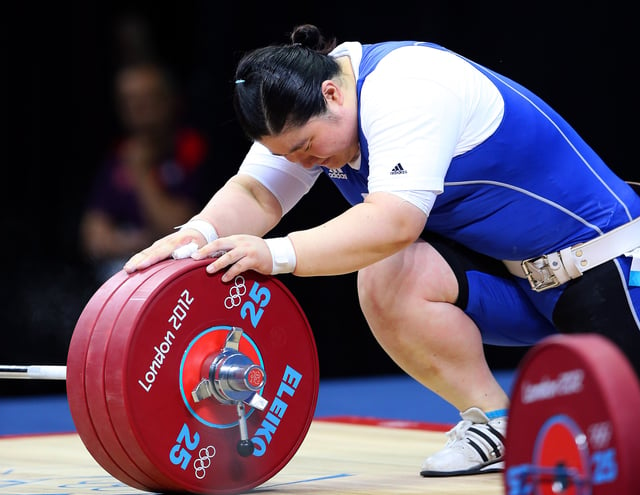
An Olympic lifter, Jang Mi-ran, holding a barbell loaded with red 25 kg bumper plates, held in place with a collar. Note the lifter's taped wrists and thumbs, her weightlifting shoes, and her weightlifting belt.
Weight plates are secured to the bar using collars on each sleeve that weigh exactly 2.5 kg each.
Singlet
Lifters typically wear a one-piece, close-fitting leotard often called a singlet. The wearing of a T-shirt underneath the singlet is optional.
Belt
A weightlifting belt of 120 mm maximum width may also be worn to increase intra-abdominal pressure.
Chalk
Chalk is regularly used by Olympic lifters, generally prior to each attempt at a lift. Lifters rub their hands with the chalk to promote dryness and prevent the bar moving in their hands. In addition to the hands, chalk can be applied to the neck, usually above the collarbone, which is a key point of contact for the bar during a clean and jerk.[9]
Tape
Olympic lifters frequently use tape to cover the areas of their bodies exposed to friction while completing Olympic lifts. Tape is most commonly found on the Olympic lifter's thumb. A taped thumb not only lessens the risk of calluses, it reduces the pain associated with the hook grip.
Olympic lifters also tape their wrists, preventing exaggerated and uncomfortable joint movement during lifts. For particularly heavy overhead lifts, a taped wrist enables the lifter to regulate wrist extension and delimit the translation of the radius and ulna distal heads. However, while taped wrists can prevent wrist and forearm injuries in the short-term, excessive use can lead to weakened connective tissue in the area, increasing the risk of pain and injury.[9]
Shoes
The type of shoes worn by Olympic weightlifters is perhaps their most distinctive piece of equipment. Weightlifting shoes are typically designed with a raised heel of 0.5" to 1.5" and one or two metatarsal straps that tighten across the instep of the shoe. The raised heel helps the lifter maintain an upright torso while catching the bar and also allows for a deeper squat under the bar. The soles of the shoes are also quite rigid, helping to resist compression while under heavy loads. The shoes are designed for maximum stability while remaining flexible in the "toebox". This allows the lifter to come up on the toes and to catch the weight on the ball of the back foot during the "jerk" movement of the lift.[9]
See also
World Weightlifting Championships
Weightlifting at the Summer Olympics
List of world records in Olympic weightlifting
List of Olympic records in weightlifting
List of Olympic medalists in weightlifting
Power training
Paralympic powerlifting